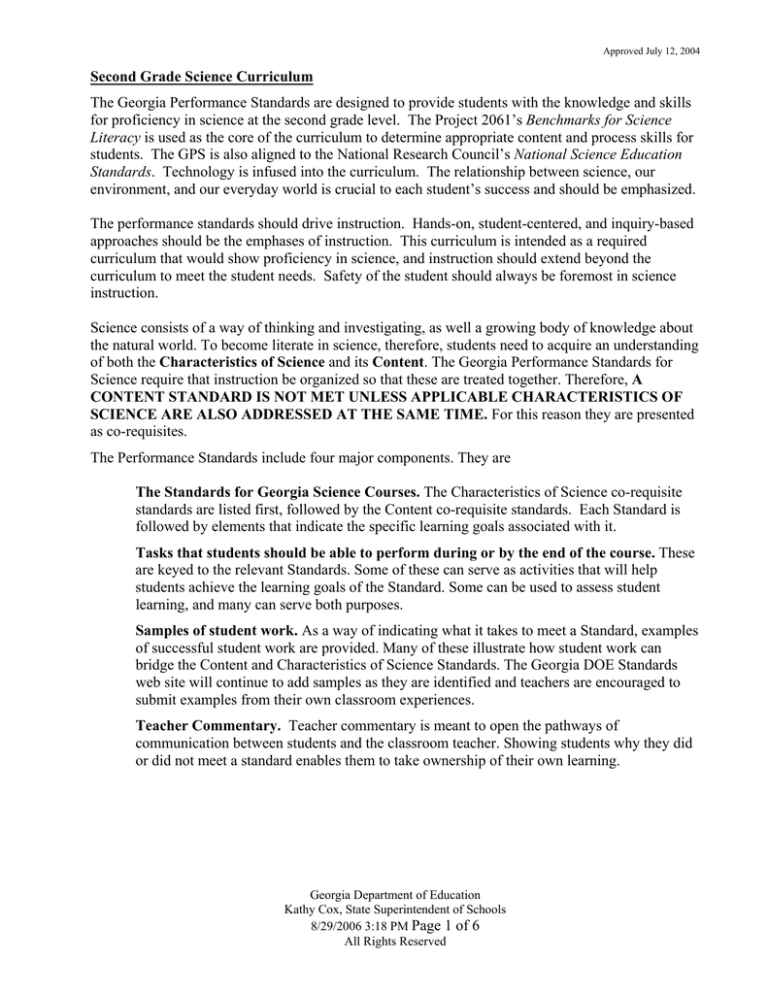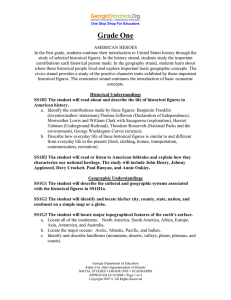
Approved July 12, 2004
Second Grade Science Curriculum
The Georgia Performance Standards are designed to provide students with the knowledge and skills
for proficiency in science at the second grade level. The Project 2061’s Benchmarks for Science
Literacy is used as the core of the curriculum to determine appropriate content and process skills for
students. The GPS is also aligned to the National Research Council’s National Science Education
Standards. Technology is infused into the curriculum. The relationship between science, our
environment, and our everyday world is crucial to each student’s success and should be emphasized.
The performance standards should drive instruction. Hands-on, student-centered, and inquiry-based
approaches should be the emphases of instruction. This curriculum is intended as a required
curriculum that would show proficiency in science, and instruction should extend beyond the
curriculum to meet the student needs. Safety of the student should always be foremost in science
instruction.
Science consists of a way of thinking and investigating, as well a growing body of knowledge about
the natural world. To become literate in science, therefore, students need to acquire an understanding
of both the Characteristics of Science and its Content. The Georgia Performance Standards for
Science require that instruction be organized so that these are treated together. Therefore, A
CONTENT STANDARD IS NOT MET UNLESS APPLICABLE CHARACTERISTICS OF
SCIENCE ARE ALSO ADDRESSED AT THE SAME TIME. For this reason they are presented
as co-requisites.
The Performance Standards include four major components. They are
The Standards for Georgia Science Courses. The Characteristics of Science co-requisite
standards are listed first, followed by the Content co-requisite standards. Each Standard is
followed by elements that indicate the specific learning goals associated with it.
Tasks that students should be able to perform during or by the end of the course. These
are keyed to the relevant Standards. Some of these can serve as activities that will help
students achieve the learning goals of the Standard. Some can be used to assess student
learning, and many can serve both purposes.
Samples of student work. As a way of indicating what it takes to meet a Standard, examples
of successful student work are provided. Many of these illustrate how student work can
bridge the Content and Characteristics of Science Standards. The Georgia DOE Standards
web site will continue to add samples as they are identified and teachers are encouraged to
submit examples from their own classroom experiences.
Teacher Commentary. Teacher commentary is meant to open the pathways of
communication between students and the classroom teacher. Showing students why they did
or did not meet a standard enables them to take ownership of their own learning.
Georgia Department of Education
Kathy Cox, State Superintendent of Schools
8/29/2006 3:18 PM Page 1 of 6
All Rights Reserved
Approved July 12, 2004
Georgia Performance Science Standards-- Explanation of Coding
Characteristics of Science Standards
SKCS1
Science Kindergarten Characteristics of Science Standard #1
S8CS2
Science Grade 8 Characteristics of Science Standard #2
SCSh8
Science Characteristics of Science high school Standard #8
Content Standards
S5P3
Science Grade 5 Physical Science Standard #3
S4E2
Science Grade 4 Earth Science Standard #2
S7L4
Science Grade 7 Life Science Standard #4
SC1
Science Chemistry Standard #1
SB4
Science Biology Standard #4
SPS6
Science Physical Science Standard #6
SP3
Science Physics Standard #3
Georgia Department of Education
Kathy Cox, State Superintendent of Schools
8/29/2006 3:18 PM Page 2 of 6
All Rights Reserved
Approved July 12, 2004
Second grade students raise questions about the world around them and seek answers by making
observations and exploring. At the appropriate times, students will ask, “How do you know?” and
will attempt to answer the question. They will use whole numbers as well as basic fractions (such as
one-half and one-fourth) to identify and analyze scientific data. Second graders will find sums and
differences of single digit numbers and then justify the answer. They will give rough estimates to
problems and estimate lengths, weights, and time intervals. They will explain to others how to solve
numerical problems related to a science activity. Second grade students know to follow safety rules.
Change
Second grade students apply ideas to things in the world. They push, pull, and manipulate things to
see what will happen. They observe changes of plants and animals as they grow and change. They
observe the changing patterns of the moon and stars. As a result, second grade students become
aware of changes that take place. They form ideas as to whether the changes are natural or
manipulated.
Major Concepts/ Skills:
Earth Science
Motion/patterns of celestial bodies
Changes of the earth’s surface
Physical Science
Changing attributes of materials
States of matter (solid, liquid, gas)
Energy to keep things going
(motion), pushes and pulls
Life Science
Life Cycles
Concepts/Skills to Maintain:
Habits of mind
Asks questions and seeks answers by observation
Uses numbers to quantify
Estimates
Assembles and takes apart
Describes changes in materials
Communicates ideas
Questions and attempts answers
Can repeat an activity and get similar results
Uses tools to gather data
Gives accurate descriptions
Co-Requisite - Characteristics of Science
Habits of Mind
S2CS1. Students will be aware of the importance of curiosity, honesty, openness, and
skepticism in science and will exhibit these traits in their own efforts to understand
how the world works.
a. Raise questions about the world around them and be willing to seek answers to some
of the questions by making careful observations and measurements and trying to
figure things out.
S2CS2. Students will have the computation and estimation skills necessary for analyzing data
and following scientific explanations.
a. Use whole numbers in ordering, counting, identifying, measuring, and describing
things and experiences.
b. Readily give the sums and differences of single-digit numbers in ordinary, practical
contexts and judge the reasonableness of the answer.
c. Give rough estimates of numerical answers to problems before doing them formally.
Georgia Department of Education
Kathy Cox, State Superintendent of Schools
8/29/2006 3:18 PM Page 3 of 6
All Rights Reserved
Approved July 12, 2004
d. Make quantitative estimates of familiar lengths, weights, and time intervals, and
check them by measuring.
S2CS3. Students will use tools and instruments for observing, measuring, and manipulating
objects in scientific activities.
a. Use ordinary hand tools and instruments to construct, measure, and look at objects.
b. Assemble, describe, take apart, and reassemble constructions using interlocking
blocks, erector sets and other things.
c. Make something that can actually be used to perform a task, using paper, cardboard,
wood, plastic, metal, or existing objects.
S2CS4. Students will use the ideas of system, model, change, and scale in exploring scientific
and technological matters.
a. Identify the parts of things, such as toys or tools, and identify what things can do
when put together that they could not do otherwise.
b. Use a model—such as a toy or a picture—to describe a feature of the primary thing.
c. Describe changes in the size, weight, color, or movement of things, and note which of
their other qualities remain the same during a specific change.
d. Compare very different sizes, weights, ages (baby/adult), and speeds (fast/slow) of
both human made and natural things.
S2CS5. Students will communicate scientific ideas and activities clearly.
a. Describe and compare things in terms of number, shape, texture, size, weight, color,
and motion.
b. Draw pictures (grade level appropriate) that correctly portray features of the thing
being described.
c. Use simple pictographs and bar graphs to communicate data.
The Nature of Science
S2CS6. Students will be familiar with the character of scientific knowledge and how it is
achieved.
Students will recognize that:
a. When a science investigation is done the way it was done before, we expect to get a
similar result.
b. Science involves collecting data and testing hypotheses.
c. Scientists often repeat experiments multiple times and subject their ideas to criticism
by other scientists who may disagree with them and do further tests.
d. All different kinds of people can be and are scientists.
S2CS7. Students will understand important features of the process of scientific inquiry.
Students will apply the following to inquiry learning practices:
a. Scientists use a common language with precise definitions of terms to make it easier
to communicate their observations to each other.
Georgia Department of Education
Kathy Cox, State Superintendent of Schools
8/29/2006 3:18 PM Page 4 of 6
All Rights Reserved
Approved July 12, 2004
b. In doing science, it is often helpful to work as a team. All team members should
reach their own individual conclusions and share their understandings with other
members of the team in order to develop a consensus.
c. Tools such as thermometers, rulers and balances often give more information about
things than can be obtained by just observing things without help.
d. Much can be learned about plants and animals by observing them closely, but care
must be taken to know the needs of living things and how to provide for them.
Advantage can be taken of classroom pets.
Co-Requisite - Content
Earth Science
S2E1. Students will understand that stars have different sizes, brightness, and patterns.
a. Describe the physical attributes of stars—size, brightness, and patterns.
S2E2. Students will investigate the position of sun and moon to show patterns throughout the
year.
a. Investigate the position of the sun in relation to a fixed object on earth at various
times of the day.
b. Determine how the shadows change through the day by making a shadow stick or
using a sundial.
c. Relate the length of the day and night to the change in seasons (for example: Days
are longer than the night in the summer.).
d. Use observations and charts to record the shape of the moon for a period of time.
S2E3. Students will observe and record changes in their surroundings and infer the causes of
the changes.
a. Recognize effects that occur in a specific area caused by weather, plants, animals,
and/or people.
Physical Science
S2P1. Students will investigate the properties of matter and changes that occur in objects.
a. Identify the three common states of matter as solid, liquid, or gas.
b. Investigate changes in objects by tearing, dissolving, melting, squeezing, etc.
S2P2. Students will identify sources of energy and how the energy is used.
a. Identify sources of light energy, heat energy, and energy of motion.
b. Describe how light, heat, and motion energy are used.
S2P3. Students will demonstrate changes in speed and direction using pushes and pulls.
a. Demonstrate how pushing and pulling an object affects the motion of the object.
b. Demonstrate the effects of changes of speed on an object.
Georgia Department of Education
Kathy Cox, State Superintendent of Schools
8/29/2006 3:18 PM Page 5 of 6
All Rights Reserved
Approved July 12, 2004
Life Science
Teacher note: Instruct students not to touch wild plants and animals when they observe them.
Always wash hands after handling any plants or animals. Caution students not to eat wild plants
they find.
S2L1. Students will investigate the life cycles of different living organisms.
a. Determine the sequence of the life cycle of common animals in your area: a mammal
such as a cat or dog or classroom pet, a bird such as a chicken, an amphibian such as
a frog, and an insect such as a butterfly.
b. Relate seasonal changes to observations of how a tree changes throughout a school
year.
c. Investigate the life cycle of a plant by growing a plant from a seed and by recording
changes over a period of time.
d. Identify fungi (mushroom) as living organisms.
Georgia Department of Education
Kathy Cox, State Superintendent of Schools
8/29/2006 3:18 PM Page 6 of 6
All Rights Reserved












